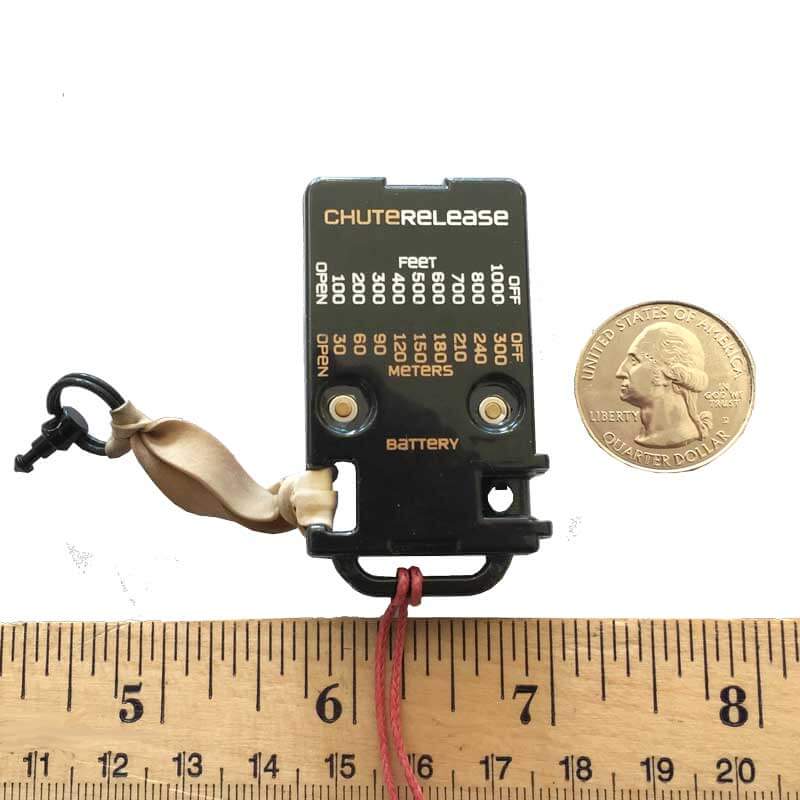The Chute Release works as follows - a rubber/elastic band is wrapped around the parachute and connected to an altimeter-controlled device which releases the band at a set altitude. It's very, very easy to use - you simply press a button to set the altitude (in 100 foot increments), and there is a setting for testing the parachute release, to make sure the chute comes free cleanly. The Chute Release is a bit on the hefty side at 0.6 ounces, and you would be hard-pressed to fit it in anything smaller than a BT-60 body tube, but these are not significant negatives. The device charges via a standard USB connector, and my first tests caused me to salivate at the thought of using it in a 2 stage Estes Omega loaded with D12's or even E12's - I could deploy the parachute at 400 feet or so and save myself a lengthy hike. Perfect for an old, chubby rocketeer!
 |
| The Jolly Logic Chute Release (Image from the Jolly Logic website). |
John Beans explains how to operate the Chute Release
Saturday I prepped my trusty clone of the Centuri RX-16. This rocket, part of the old Centuri Power System, was an appropriate choice, as it is based on a BT-60 (actually, ST-16) tube and was marketed as a "science testbed"; peak altitude was determined by timing the fall of a ping pong ball kicked out by the rocket at parachute ejection. It also featured interchangeable motor mounts, and the afternoon's flight used the single 24 mm mount, loaded with an Estes D12-5. I had to go with the D12, as the RX-16 would also carry a keychain camera in an attempt to image the deploy; this adds another 0.5 ounces of weight, on top of the additional 0.6 ounces of the Chute Release. As mentioned in my previous post, a tiny Altus Metrum altimeter was loaded in the payload section.
 |
| Clone of the Centuri RX-16 (Click to enlarge). |
The RX-16 was the first one launched Saturday. It quickly lifted off the pad, arcing into the strong southern wind; ejection occurred a couple of seconds after apogee. I held my breath as I watched the model fall, the parachute fluttering behind, held closed by the Chute Release. I began breathing again when I saw the bright orange canopy open wide at about the right height, and the model descended to a safe landing on the grass. Success! All that remained now was to look at the data, which I did as soon as I got back to the apartment. The altimeter data and video were downloaded to my Mac, and I then proceeded into Nerd analysis heaven.
The altimeter data was first up - It showed the RX-16 achieved an altitude of 542 feet, with ejection occurring 2 seconds past apogee, at 7.8 seconds into the flight. The descent rate abruptly changed from 36 feet per second to 16 feet per second 14.1 seconds into the flight, indicating that the parachute had fully deployed. This happened at an altitude of 260 feet, some 40 feet below the 300 foot altitude programmed into the Chute Release. A look at the video placed ejection at frame 371, and the Chute Release was clearly separated from the parachute at frame 526, 4.65 seconds after ejection. This suggests the Chute Release let go of the parachute about 12.4 seconds after launch, at which time the somewhat noisy altimeter data gives a height of 325 feet. It then took about 1.7 seconds or 60ish feet for the parachute to fully open - in good agreement with the instructions.
 |
| RX-16 flight summary (Click to enlarge). |
 |
| RX-16 altitude profile (Click to enlarge). |
 |
| Parachute held closed by the Chute Release (Click to enlarge). |
 |
| Unfurled parachute and the Chute Release (Click to enlarge). |
Time to break out the wallet, rocketeers. Find a vendor on the Net, and buy one!











